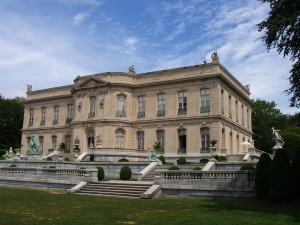Take some European marble, add some ornate, carved plaster and gold leaf, some rococo shells, a few good luck charms and there you have it—Newport, Rhode Island. Well actually, the mansions of Newport that line Bellevue Avenue, overlooking the Atlantic.
I had been there once before, but it was mid-winter. And walking through expansive grounds and admiring the pounding shoreline wasn’t all it could be. So just this past weekend, my husband and I returned to celebrate our anniversary. And not only did it impress—it amazed.
Once sprawling, wooden Victorians with grand wrap-around porches and properties, the Gilded Age (late 1800’s to early 1900s) ushered in a whole new era of millionaires to the American industrial scene. The Vanderbilts, Carnegies, Morgans, Astors—all with New York City as home base, began their summer jaunts up the New England coastline and made their way to the very beautiful shorelines of Rhode Island. One by one, society folks began to tear down the incredible sea ‘cottages’ that lined the streets and built bigger, better ones. Mansions, in fact. Mansions modeled after European royal ones. Louis the XlV style furnishings imported from overseas. Neighbor upon neighbor of society elite lined up property after property to out do and up do their neighbors. Privet hedges kept the privacy, as the nouveau riche out gilded and gauded the commoners who paved their way. Elite, but beautiful. And extremely interesting historically speaking.
What may be most striking, besides the magnitude of wealth (and the fact that the movie The Great Gatsby was filmed there), was the historical interaction between families of privilege. Money married money, as you might guess, making it easier to understand how the original captains of industry networked themselves and their families into other equally prominent families, ensuring that their fortune and favor would continue for generations to come. Not surprising why they took so much comfort in their dealings with french society. They were following in the nobility of our European predecessors, who married empires to each other to ensure luxury long down the line.
The beauty of the setting took our breath away. But so did the complete ostentatiousness of it all. The shrines dedicated to oneself. And the unashamed consumption, from the ridiculous to the sublime. A taxidermist stuffed pet that could be made to fly? A pet masquerade banquet? Gilded everything? The need to hide the female help? Empty mansions left from empty marriages? ‘Cottages that were lived in often no more than two months/year? More than 10 different outfits per day? A waitstaff that stood behind each dinner guest to attend to their every need? Priceless. Ridiculous.
So in essence, while enclaves like Newport aren’t quite as flagrantly obvious, the nouveau riche of any day seem to follow suit. The more you have, the more you spend. The more you spend, the more you want. I came away with a great awakening—Chasing wealth is commonplace. But achieving it is far from it—and that’s the danger. With extreme wealth often comes extreme isolation and insulation from reality–the needs and demands of the real world; the plight of those with real need.
If you haven’t seen Newport, it’s a study in wealth and human nature. For the price of a nice meal, you can walk into a stream of mansions and take the tours of the day through the halls of yesteryear. But Newport is also a most beautiful environment, where the waves are high, the ocean deep blue and the manicured grounds, just beautiful.








Great piece. Wouldn’t want to live that way, but would love to visit. On the vacation must list!